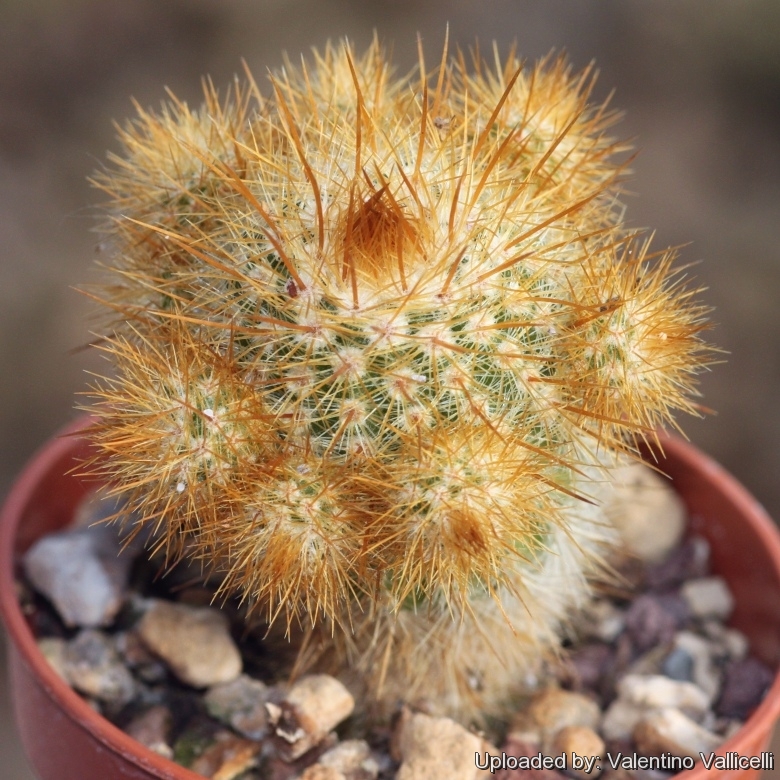
Parodia tenuicylindrica Photo by: Valentino Vallicelli
Origin and Habitat: Parodia tenuicylindricaSN|25110]]SN|25110]] has a relatively small range in Brazil (Rio Grande do Sul) and in Uruguay (Rivera, Artigas, Salto, Tacuarembó), with an extent of occurrence of 5,000-6,000 km2.
Altitude: 50-200 metres above sea level.
Habitat: Parodia tenuicylindricaSN|25110]]SN|25110]] grows sparsely distributed on rocky outcrops, in grasslands or pampas and is abundant where it occurs. The major threats are fires, cattle grazing due to trampling, agriculture, and forestry.
Synonyms:
See all synonyms of Parodia tenuicylindrica
back
Accepted name in llifle Database:Parodia tenuicylindrica (F.Ritter) D.R.HuntCactaceae Consensus Init. 4: 6. 1997 [Oct 1997]Synonymy: 6
back
Description: Parodia tenuicylindricaSN|25110]]SN|25110]] (Notocactus tenuicylindricusSN|25111]]SN|25111]]) is one of the smaller species in the genus with tiny yellow red-brown spines and white wool remembering of a Frailea.
Stem: Unbranched, cylindric up to 4-8 cm tall and 2-3 cm, in width (though in cultivation it grows much larger) green or bluish green.
Ribs: 13-21,3-4 mm high, more or less notched.
Areoles: 1,5- 3 cm apart with white wool.
Central spines: Between 2 and 4, 3-6 mm long (rarely up to 1,5 cm) red brown strong, straight, pungent and acicular. The lowermost occasionally hooked and more or less strong.
Radial spines: 10 to15 creamy-white to pale yellow 3-4 mm in long.
Flowers: 2,5-3 cm tall and 4-5 cm in diameter, bright lemon yellow, stigmas dark red. Pericarpel and flower tube with purple scars filled almost entirely with white wool and yellow bristles.
Fruits: Yellow-green.
Seeds: Black oblongs with tubercles.
Subspecies, varieties, forms and cultivars of plants belonging to the Parodia tenuicylindrica group
 Parodia minima (Frič & Kreuz. ex Buining) hort. non F.H.Brandt: is an older name still used in cultivation and referable to a smaller form of Parodia tenuicylindrica, but differences are arguable.
Parodia minima (Frič & Kreuz. ex Buining) hort. non F.H.Brandt: is an older name still used in cultivation and referable to a smaller form of Parodia tenuicylindrica, but differences are arguable. Parodia tenuicylindrica (F.Ritter) D.R.Hunt: This is one of the smaller species in the genus with tiny yellow and red-brown spines, white wool remembering of a Frailea.
Parodia tenuicylindrica (F.Ritter) D.R.Hunt: This is one of the smaller species in the genus with tiny yellow and red-brown spines, white wool remembering of a Frailea.
Bibliography: Major references and further lectures
1) Edward F. Anderson “The Cactus Family” Timber Press, 2001
2) Curt Backeberg “Cactus Lexicon” Sterling Publishing Company, Incorporated, 1978
4) Hiroshi Hirao “Colour encyclopaedia of cacti” Japan (Japanese language and script)1979
5) Willy Cullmann, Erich Götz (Dozent Dr.), Gerhard Gröner “The encyclopedia of cacti” Portland, OR: Timber Press, 1986
6) David Hunt, Nigel Taylor “The New Cactus Lexicon” DH Books, 2006
7) James Cullen, Sabina G. Knees, H. Suzanne Cubey “The European Garden Flora Flowering Plants: A Manual for the Identification of Plants Cultivated in Europe, Both Out-of-Doors and Under Glass” Cambridge University Press, 11/Aug./2011
8)Edward F. Anderson: “Das Grosse Kakteen-Lexikon.” Eugen Ulmer KG, Stoccarda 2005 (übersetzt von Urs Eggli)
9) Larocca, J., Machado, M. & Duarte, W. 2013. Parodia tenuicylindrica. In: IUCN 2013. "IUCN Red List of Threatened Species." Version 2013.2. <www.iucnredlist.org>. Downloaded on 02 January 2014.
Cultivation and Propagation: Parodia tenuicylindricaSN|25110]]SN|25110]] is an easy to grow tropical cactus, more cold tolerant than most and less fussy regarding soil conditions.
Growth rate: It is a relatively slow growing but easily flowering species.
Soils: It likes very porous standard cactus mix soil.
Repotting: Use pot with good drainage.
Watering: Water regularly in summer, but do not overwater (Rot prone), keep dry in winter. It rot easily if the substrate is wet and cold, tends to lose its roots in winter. Best if watered with rain water.
Fertilization: Feed it once during the growing season with a fertilizer specifically formulated for cactus and succulents (poor in nitrogen), including all micro nutrients and trace elements diluted to ½ the strength recommended on the label. It thrives in poor soils and need a limited supplies of fertilizer to avoid the plants developing excess vegetation, which is easily attacked by fungal diseases.
Hardiness: Reputedly sensitive to frost, but less so if kept on the dry side prior to, and during, cold weather (hardy to -5° C for short periods). However warmth throughout the year will increase the grower's success (8-12°C during rest season).
Exposition: Outside bright but partially filtered sunlight or afternoon shade, inside it needs bright light, and some direct sun. Subject to sunburn if exposed to direct sun for too long. Tends to bronze in strong light, which encourages flowering and heavy wool and spine production.
Uses: It is an excellent plant for container growing. It always looks good and stays small. It look fine in a cold greenhouse and frame or outdoor in a rockery.
Pests & diseases: It may be attractive to a variety of insects, but plants in good condition should be nearly pest-free, particularly if they are grown in a mineral potting-mix, with good exposure and ventilation. Nonetheless, there are several pests to watch for:
- Red spiders: Sensitive to red spider mite. Overhead watering is helpful in controlling mites.
- Mealy bugs: Occasionally mealy bugs they develop aerial into the new growth among the wool with disfiguring results, but the worst types develop underground on the roots and are invisible except by their effects.
- Scales: Scales are rarely a problem.
- Rot: Rot it is only a minor problem with cacti if the plants are watered and “aired” correctly. If they are not, fungicides won't help all that much.
Propagation: Division, direct sow after last frost. Seeds germinate in 7-14 days at 21-27° C in spring, remove the glass cover gradually as the plants develops and keep ventilated, no full sun for young plants! To make a cutting twist off a branch and permit it to dry out a couple of weeks, lay it on the soil and insert the stem end partially into the soil. Try to keep the cutting somewhat upright so that the roots are able to grow downward.










